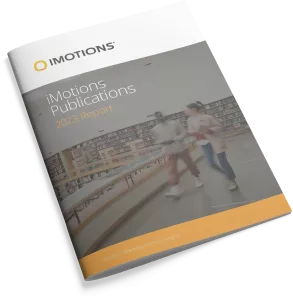-
Influence of Label Design and Country of Origin Information in Wines on Consumers’ Visual, Sensory, and Emotional Responses
This study aimed to evaluate the influence of origin information on Pinot Noir wine labels using eye-tracking and its associations with purchase intent, and hedonic and subconscious emotional responses. Two studies were carried out on untrained university staff and students aged 20–60 years old. Study 1 was conducted to assess consumers’ (n = 55; 55% males, […]
-
Automotive Emotions: The Effect of Gender
The emotional responses to interactions with automobiles can provide insights into what works well and what works less well for people. The measurement of human emotions has thus become increasingly popular in recent times. A question which can however arise is whether statistically significant differences can occur due mainly to gender. The present investigation analysed […]
-
Measuring the Impact of Packaging in Wine, a Neuromarketing Study
The wine sector is of extraordinary relevance in Spain, not only from an economic or environmental point of view, but also from a social and cultural point of view. In this research work for Gil Family Estates (a Spanish company in the wine sector), results of a market study with three approaches will be presented: […]
-
“Sound” Decisions: The Combined Role of Ambient Noise and Cognitive Regulation on the Neurophysiology of Food Cravings
Our ability to evaluate long-term goals over immediate rewards is manifested in the brain’s decision circuit. Simplistically, it can be divided into a fast, impulsive, reward “system 1” and a slow, deliberate, control “system 2.” In a noisy eating environment, our cognitive resources may get depleted, potentially leading to cognitive overload, emotional arousal, and consequently […]
-
Data-driven analysis of gaze patterns in face perception: Methodological and clinical contributions
Gaze patterns during face perception have been shown to relate to psychiatric symptoms. Standard analysis of gaze behavior includes calculating fixations within arbitrarily predetermined areas of interest. In contrast to this approach, we present an objective, data-driven method for the analysis of gaze patterns and their relation to diagnostic test scores. This method was applied to […]
-
Capturing food-elicited emotions: Facial decoding of children’s implicit and explicit responses to tasted samples
Sensory and consumer research increasingly aims to gain direct input from children to study their eating behaviour. However, answering self-administered questionnaires can be challenging for children. In this sense, the prediction of basic emotions via facial decoding, generating quantitative observational data, could offer an alternative to questionnaires. The present study aimed to measure children’s implicit […]
-
Caught in the Act: Detecting Respondent Deceit and Disinterest in On-Line Surveys. A Case Study Using Facial Expression Analysis
Much social marketing research is done on-line recruiting participants through Amazon Mechanical Turk, vetted panel vendors, social media, or community sources. When compensation is offered, care must be taken to distinguish genuine respondents from those with ulterior motives. We present a case study based on unanticipated empirical observations made while evaluating perceived effectiveness (PE) ratings […]
-
The Use of Eye Tracking as a Measure of Situation Awareness in Power System Control Rooms
Power systems control rooms are fast-paced, dynamic environments that require operators to maintain awareness of numerous pieces of information. A construct that has been previously used to examine operator ability to process and retain information is situation awareness. It is the process by which information is perceived, comprehended, and then used to project events that […]
-
Exploring Visitors’ Visual Behavior Using Eye-Tracking: The Case of the “Studiolo Del Duca”
Although the understanding of cognitive disciplines has progressed, we know relatively little about how the human brain perceives art. Thanks to the growing interest in visual perception, eye-tracking technology has been increasingly used for studying the interaction between individuals and artworks. In this study, eye-tracking was used to provide insights into non-expert visitors’ visual behaviour […]
-
Pistol: Pupil Invisible Supportive Tool to extract Pupil, Iris, Eye Opening, Eye Movements, Pupil and Iris Gaze Vector, and 2D as well as 3D Gaze
This paper describes a feature extraction and gaze estimation software, named Pistol that can be used with Pupil Invisible projects and other eye trackers in the future. In offline mode, our software extracts multiple features from the eye including, the pupil and iris ellipse, eye aperture, pupil vector, iris vector, eye movement types from pupil […]
Research Report 2023
In-depth look at the scientific landscape as powered by iMotions software, showcasing groundbreaking research and the impact of our tools in various scientific and industrial fields.

Share Your Research

850+ universities worldwide with an iMotions human behavior lab
73 of the top 100 highest ranked universities
710+ published research papers using iMotions
iMotions is used for some of the most interesting human behavior research studies carried out by top researchers around the world. Contact us to have your publication featured here.
The authors of these publications have used iMotions as a software tool within their research.
“Software should be cited on the same basis as any other research product such as a paper or a book; that is, authors should cite the appropriate set of software products just as they cite the appropriate set of papers” (Katz et al., 2020).
We therefore encourage you to cite the use of iMotions where appropriate.
How to cite iMotions
APA
iMotions (10), iMotions A/S, Copenhagen, Denmark, (2024).
Note: adjust the version and year where relevant.
5 Most Popular Blogs
Learn How to Conduct Human Behavior Research with iMotions
Publications
Read publications made possible with iMotions
Blog
Get inspired and learn more from our expert content writers
Newsletter
A monthly close up of latest product and research news





